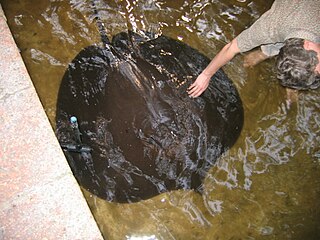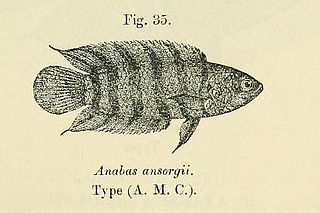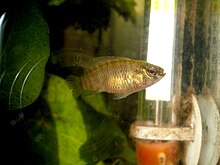
The South Asian river dolphin is an endangered freshwater or river dolphin found in the region of Indian subcontinent, which is split into two subspecies, the Ganges river dolphin and the Indus river dolphin. The Ganges river dolphin is primarily found in the Ganges and Brahmaputra Rivers and their tributaries in India, Bangladesh, and Nepal, while the Indus river dolphin is now found only in the main channel of the Indus River in Pakistan and active channels connected to it between the Jinnah and Kotri barrages, and in the River Beas in Punjab in India. From the 1970s until 1998, they were regarded as separate species; however, in 1998, their classification was changed from two separate species to subspecies of a single species. The Ganges river dolphin has been recognized by the government of India as its National Aquatic Animal and is the official animal of the Indian city of Guwahati. The Indus river dolphin has been named as the National Mammal of Pakistan.

The giant danio is a tropical fish belonging to the minnow family Cyprinidae. Originating in Sri Lanka, Nepal, and the west coast of India, this species grows to a maximum length of 4 inches (10 cm), making it one of the largest of the danionins. It is characterized by a blue and yellow, torpedo-shaped body with gray and clear fins.

The sailfin molly is a species of fish of the genus Poecilia. They inhabit fresh, brackish, salt, and coastal waters from North Carolina to Texas and the Yucatán Peninsula of Mexico.

The rock bass, also known as the rock perch, goggle-eye, red eye, is a freshwater fish native to east-central North America. This red eyed creature is a species of freshwater fish in the sunfish family (Centrarchidae) of order Perciformes and can be distinguished from other similar species by the six spines in the anal fin.

The green sunfish is a species of freshwater fish in the sunfish family (Centrarchidae) of order Perciformes. A panfish popular with anglers, the green sunfish is also kept as an aquarium fish by hobbyists. They are usually caught by accident, while fishing for other game fish. Green sunfish can be caught with live bait such as nightcrawlers, waxworms, mealworms, and blood worms. Grocery store baits such as pieces of hot dog or corn kernels can even catch fish. Green sunfish are aggressive and will hit small lures. They can be caught with fly fishing tackle.

The rainbow darter is a native North American perch-like freshwater fish found in small, fast-moving streams and small to medium-sized rivers. It grows to 2 to 3 inches in length. The species is very sensitive to pollution and silt, staying in clean, pollution-free water. The rainbow darter is easily identified by three dark spots on the back, and blue and orange in the dorsal and anal fins.

Channa bleheri is a species of dwarf snakehead that is endemic to the Brahmaputra River basin in the Indian states of Assam and Arunachal Pradesh. It is among the most colorful species of snakehead.

The Indian flapshell turtle is a freshwater species of turtle found in South Asia. The “flap-shelled” name stems from the presence of femoral flaps located on the plastron. These flaps of skin cover the limbs when they retract into the shell. It is unclear what protection the flaps offer against predators. Indian flapshell turtles are widespread and common in the South Asian provinces.

The giant freshwater stingray is a species of stingray in the family Dasyatidae. It is found in large rivers and estuaries in Southeast Asia and Borneo, though historically it may have been more widely distributed in South and Southeast Asia. One of the largest freshwater fish in the world, this species grows upwards of 1.9 m (6.2 ft) across and may reach 600 kg (1,300 lb) in weight. It has a relatively thin, oval pectoral fin disc that is widest anteriorly, and a sharply pointed snout with a protruding tip. Its tail is thin and whip-like, and lacks fin folds. This species is uniformly grayish brown above and white below; the underside of the pectoral and pelvic fins bear distinctive wide, dark bands on their posterior margins.

Microctenopoma ansorgii is a small freshwater fish, known in the aquarium trade as the ornate ctenopoma, orange ctenopoma, ornate climbing perch, pretty ctenopoma, or rainbow ctenopoma. It is related to the more familiar spotted climbing perch, but looks very different. Its body is more elongated and rounded, with fins with red and black stripes; the color intensifies when the fish are displaying, with black bars becoming visible on the body. The ornate ctenopoma spawns at night, laying its eggs on a floating bubble nest like its relatives in the osphronemidae. It lives in the slow-flowing forest streams of the Congo Basin, where it feeds on worms, insect larvae, and other aquatic invertebrates. It is the most common member of its genus in the aquarium trade, where it is known for being a shy, easily bullied fish that needs live or frozen foods and which benefits from the presence of smaller dither fish to encourage it to come out of hiding.

The banded lampeye is a species of poeciliid that is native to Africa, ranging from Senegal to Angola. It is mainly found in coastal brackish habitats such as river mouths, lagoons and mangrove swamps. It reaches up to 7 cm (2.8 in) in total length.

The blue lyretail, also known as steel-blue aphyosemion and Gardner's killi. It is a species of killifish from Nigeria and Cameroon.

The wildlife of Pakistan comprises a diverse flora and fauna in a wide range of habitats from sea level to high elevation areas in the mountains, including 177 mammal and 660 bird species. This diverse composition of the country's fauna is associated with its location in the transitional zone between two major zoogeographical regions, the Palearctic, and the Oriental.

Chitala chitala is a knifefish from Bangladesh, India, Nepal and Pakistan, where found in the Indus, Ganges, Brahmaputra and Mahanadi River basins. It is sometimes known as the Indian featherback/knifefish. In the past it frequently included several related Chitala species, but these are now regarded as separate species. The main species confused with this species is C. ornata ; a Southeast Asian species seen regularly in the aquarium trade. The true C. chitala is very rare in the aquarium trade.

The scarlet badis is a tropical freshwater fish and one of the smallest known percoid fish species. It is a micropredator, feeding on small aquatic crustaceans, worms, insect larvae and other zooplankton. It is sold under a variety of names in the aquarium trade.

The Badidae are a small family which has been placed in the order anabantiforme fishes. However, the 5th edition of Fishes of the World classifies the family as being a sister to the Anabantiformes, along with the Nandidae and Pristolepididae in an unnamed and unranked but monophyletic clade which is a sister to the Ovalentaria within the wider Percomorpha. Members of this family are small freshwater fish that are found in Bangladesh, Bhutan, China, India, Laos, Myanmar, Nepal, Pakistan and Thailand. The largest is Badis assamensis that reaches a standard length of up to 7.5 cm (3 in), while the smallest, Dario dario, does not exceed 2 cm (0.8 in).

Badis is a genus of freshwater fish in the family Badidae found in South Asia, Southeast Asia and China. These species have a sharp spine on the opercle, soft and spinous parts of the dorsal fin contiguous, three spines in the anal fin, tubed pores in the lateral line, villiform teeth and a rounded caudal fin. In addition, they differ from the related genus Dario by being larger and displaying more involved parental care.

Badis ruber is a species of freshwater ray-finned fish from the family Badidae. It is found in Mekong, Salween and Irrawaddy basins in China, Laos and Thailand.

Badis khwae is a species of freshwater ray-finned fish from the family Badidae. It is native to Thailand.

The threestripe gourami, also known as the Mekong croaking gourami, is a species of freshwater ray-finned fish from the subfamily Macropodusinae which is part of the gourami family Osphronemidae. It is native to south-east Asia.





















